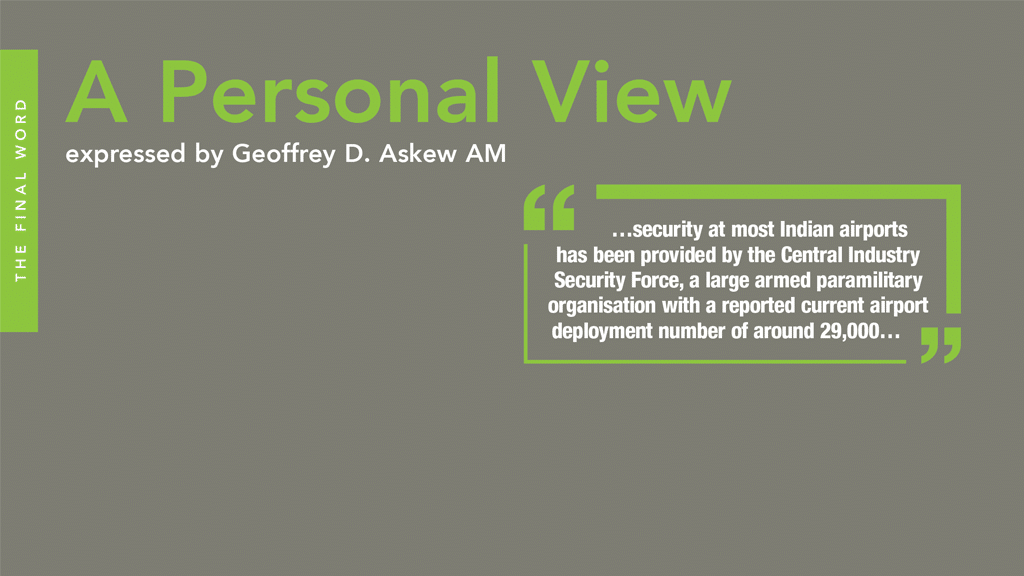Aviation security in India needs re-engineering!
The air transport industry is acknowledged by economists, politicians and the global business community as an essential element for global, regional and country economic development.
The civil aviation industry in India has, in recent years, become one of the fastest growing industries in the country. According to IATA, India will displace the UK as the third largest aviation market in the world by 2026.
In 2016 the Indian Government published the National Civil Aviation Policy (NCAP 2016), which “proposed to take flying to the masses by making it affordable and convenient.”
Based on the Worldmeters elaboration of the latest United Nations data, India will have a population by mid-2020 of 1.38 billion people or 17.7% of the world population. With an annual population growth of 1.11% it is expected to surpass China by 2024 as the most populous country in the world.
Whilst there are numerous publications tracking and analysing the economic growth of India, what is unquestionable is the significant growth of the middle class, with some reports suggesting that it will represent more than 40% of the Indian population in the near future.
Despite the capacity constraints caused by the grounding of India’s largest commercial passenger airline Jet Airways in April 2019, Arum Kumar, Director General of the Indian Directorate General of Civil Aviation, has estimated a growth in the domestic market for 2019 of between 4-5%. The Asian Development Bank expects the Indian economy to expand by more than 7% this year.

The welcome growth of the middle class and the Indian economy, along with the expansion of operations by low cost carries (LCCs) in India, will create significant challenges for the growing aviation industry, including airport infrastructure and aviation security.
New airports are under construction and many current ones are undergoing significant expansion and upgrades. The Indian Civil Aviation Ministry’s Vision 2020 plan stresses a need to develop the country’s infrastructure, with a particular focus on well-equipped, user-friendly airports to handle as many as 280 million passengers per year by 2020.
Vision 2040 also highlights the growth of the Indian civil aviation industry. India, it says, will require 200 airports to handle a minimum of 1.1 billion passengers flying to, from and within the country by 2040.
Airports, including Delhi, Mumbai, Bangalore, Hyderabad and Cochin have been operating as leased airports under a public-private partnership (PPP) model for some time. Last year, another six airports were leased out for operations, management and development under the PPP model.
There is no doubt the threat to the aviation industry in India is real and the general security environment presents ongoing concerns and challenges for the government.
Since 2000, security at most Indian airports has been provided by the Central Industry Security Force (CISF), a large armed paramilitary organisation with a reported current airport deployment number of around 29,000. State police provide security services at the small number of other commercial airports.
The deployment of the CISF is, according to their own management, anti-hijacking focused. Core functions include the verification of travel documents against identity documents at the entrance to terminals, armed patrols inside and outside of the terminals, access control duties at airside pedestrian and vehicles access points, CCTV system monitoring and screening duties at the checkpoint. Interestingly, the screening of checked bags is undertaken by terminal or airline security staff.
At the checkpoint, passengers walk through an archway (walk-through) metal detector; however, regardless of whether or not the unit alarms, females will be escorted to a private enclosure for a pat-down search, and males are subjected to screening by a handheld metal detector. This is inefficient and the effectiveness is questionable.
The CISF has begun to review some of its processes and deploy some body-scanning screening technologies at major airports, although there remains scepticism about the effectiveness of such screening by some in their ranks.
In the NCAP 2016, the government stated that it would encourage the use of private security agencies at airports for non-core security functions which will be decided in consultation with the Ministry of Home Affairs. In 2019, the International Institute of Security and Safety Management submitted a report to the Indian Government on ‘The Role Private Security Can Play in Aviation Security in India’.
There is no doubt that private security could provide professional security services and significant economic benefits to the industry whilst performing the so-called non-core security functions currently performed by the CISF.
Aviation security should be intelligence led, risk-based and outcome focused. Security outcomes must also be accompanied by courteous and practical facilitation. If the Indian aviation industry is to be safe, secure and economically viable, whilst taking advantage of the benefits that the forecast growth will deliver, it must change. A holistic approach to the management of aviation security is required, supported by advanced, state-of-the-art technologies and well-established global best practice processes and training.
Aviation security in India requires re-engineering if India is to become an aviation industry powerhouse and meet the ambitious vision, mission and objectives of the NCAP 2016.
Geoffrey D. Askew AM is Principal, Askew and Associates.
